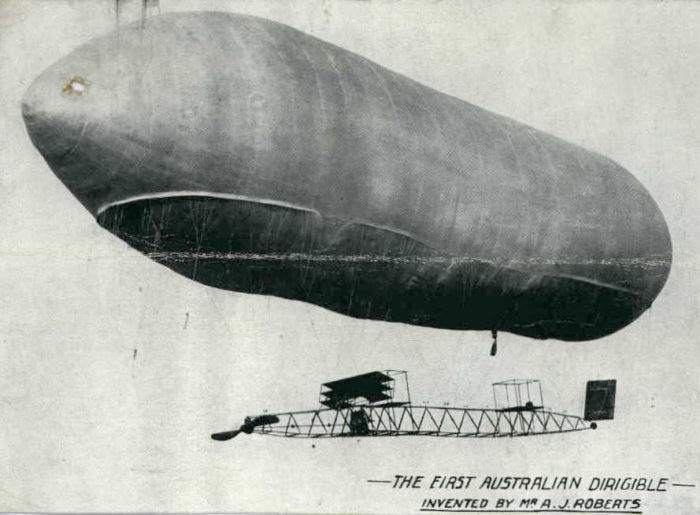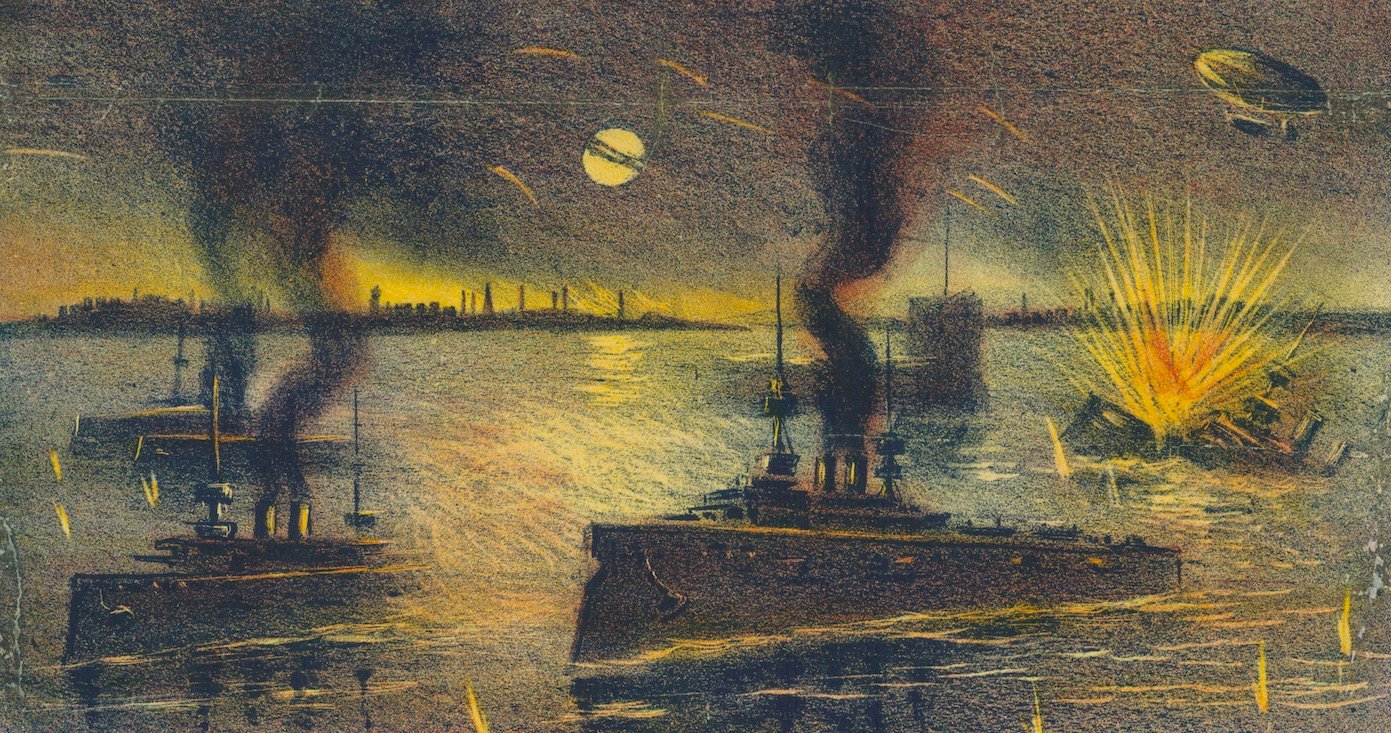I ended the previous post in this series with the tease:
In a final post, I will discuss what [Alban] Roberts called his airship, and what it might mean.
That was over two months ago! I think it’s time to finally reveal the answer to this question.
Errol Martyn, who has written what must be the fullest account of Roberts’ career, says that around the time of the airship’s tethered test, it was ‘patriotically named Australia 1‘.1 He gives no source for this name and I couldn’t find a reference to it in Trove or elsewhere. In fact, most of the press accounts don’t call it anything other than ‘the airship’ or ‘the dirigible’. But not all:
Mr A. J. Roberts’s airship, the White Australia, left the Show Ground yesterday under its own gas […]2
and
The trial flight of Mr A. J. Roberts’ airship, White Australia, from the Sydney Showground, ended abruptly on Sunday afternoon.3
I find this extraordinary. Australia’s first airship was named for a racist policy of ensuring an Australian nation free from non-Europeans. Why?
There’s no explanation given in the press accounts from 1914, which is interesting in itself — it apparently wasn’t unusual or noteworthy enough to warrant comment. The most obvious explanation for the name would be that Roberts had military uses for his airship in mind, that it was intended to be used in defence of Australia in some future war with Japan or some other Asian power. But there’s nothing about this possibility in the press either, even after the war with Germany began on 4 August, after the two Sydney flights but well before the final flight over Melbourne. Roberts did talk about his (unrealised) plans for the White Australia, but they were wholly peaceful and commercial:
It will carry six persons, and after the trial flights it will be used as a pleasure craft. Passengers will be carried over Sydney. The airship may also be used at night time as an illuminated advertised hoarding.4
But that doesn’t mean that Roberts didn’t also hope to sell White Australia to the military, which after all was potentially the biggest market — even in Australia (the Army’s first flight took place in March), or more likely Britain, where Roberts had based himself between 1908 and 1911, working with balloons, aeroplanes and his first airship, of the Astra Clément-Bayard type (which he crashed into the sea near New York City in July 1911, nearly losing his life in the process). In particular, with the Australian engineer Francis Healey he had tried to develop wireless control of both airships and torpedoes for sale to the War Office or the Admiralty, ultimately without success. (The only fruit of this was a small, 20-foot long radio-controlled airship which Roberts used in theatre performances, in competition with — perhaps even the inspiration for — Raymond Phillips.)5
When Roberts returned to Australia in 1912, he wrote an article for the Sydney Sun on the topic of ‘Australia’s air navy’.6 After summarising his experience in aeronautical research, he put forward his argument that
To my mind the dirigible should be the type of craft used for the main purposes of defence and attack, and the winged craft for reconnoitring and for general scouting purposes, particularly when there are few men to man the airship […] It is almost certain that the airship will be enabled to take up almost a vertical position over its object on many occasions, and thus it will have merely to use the force of gravity to bring destruction down upon its objective.7
Interestingly, Roberts also claimed that
I hope in a few months to be able to show Australia by means of practical demonstrations over Sydney Harbor [sic] what can be done by this means of attack, and I hope also to be able to experiment on land as well with all types of flying machines.8
He didn’t carry out such a demonstration in 1912 or any other time, but perhaps this was the genesis of his 1914 flights, perhaps delayed by difficulties in perfecting his latest idea:
if an invention of mine comes to such fruition as I expect it will, I think I shall be able to make any dirigible absolutely invisible whilst in the air […] But already I have completed the wireless driven airship, by means of which I can send an airship practically any distance without having to depend upon the pilot on board. I can also, if necessary, with the aid of mechanical devices, drop bombs when there is no pilot at all in the ship […]8
Still, there’s no explanation here of the name White Australia or for that matter, just who Australia needed to be defended against. As I’ve come to the end of my evidence, I think the only answer to that was that it was so obvious that it didn’t need to be stated that it was Japan.
And that’s all I know about the White Australia, Australia’s first and most racist airship.
(Roberts himself kept going, though he seems to have descended into showmanship, if not outright charlatanry. In 1915 his brother claimed that the Germans had stolen his wireless airship idea, after reports that they were planning to launch something similar from Zeppelins as aerial torpedoes against the British fleet.9 He joined the RNAS in 1916, apparently working on airships; after the war he was referred to as Captain Roberts. In 1920 he demonstrated a robotic Kaiser in London, in 1924 he toured Germany with a death ray, in 1928 he was back in London with another robot, in 1930 he patented an aerial advertising device. In many ways he seems to have been another Grindell Matthews.)
Image source: National Archives of Australia, A2023, A38/2/147/677 (from the application of Colin Hall, Roberts’ mechanic, for a position at the Central Flying School).
![]() This work is licensed under a Creative Commons Attribution-NonCommercial-NoDerivatives 4.0 International License.
Permissions beyond the scope of this license may be available at http://airminded.org/copyright/.
This work is licensed under a Creative Commons Attribution-NonCommercial-NoDerivatives 4.0 International License.
Permissions beyond the scope of this license may be available at http://airminded.org/copyright/.
- Errol W. Martyn, A Passion for Flight: New Zealand Aviation Before the Great War, Volume 3: The Joe Hammond Story and Military Beginnings 1910-1914 (Upper Riccarton: Volplane Press, 2013), 98. [↩]
- Sun (Sydney), 5 July 1914, 4. [↩]
- Maitland Daily Mercury, 6 July 1914, 6. [↩]
- Ballarat Star, 24 June 1914, 1. [↩]
- Martyn, A Passion for Flight, 83-97. [↩]
- Sun (Sydney), 18 March 1912, 2. [↩]
- Ibid. This idea that airships would be able to hover over their targets and simply drop bombs on them with great accuracy was quite common before 1914. In fact here Roberts has plagiarised almost verbatim a passage from R. P. Hearne, Airships in Peace and War: Being the Second Edition of Aerial Warfare with Seven New Chapters (London: John Lane, the Bodley Head, 1910), 112. [↩]
- Ibid. [↩] [↩]
- Sun (Sydney), 11 July 1915, 1. [↩]





Pingback: Australia and the airship — IV – Airminded